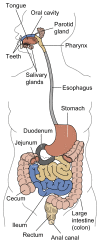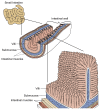Alcohol's role in gastrointestinal tract disorders
- PMID: 15706765
- PMCID: PMC6826790
Alcohol's role in gastrointestinal tract disorders
Abstract
When alcohol is consumed, the alcoholic beverages first pass through the various segments of the gastrointestinal (GI) tract. Accordingly, alcohol may interfere with the structure as well as the function of GI-tract segments. For example, alcohol can impair the function of the muscles separating the esophagus from the stomach, thereby favoring the occurrence of heartburn. Alcohol-induced damage to the mucosal lining of the esophagus also increases the risk of esophageal cancer. In the stomach, alcohol interferes with gastric acid secretion and with the activity of the muscles surrounding the stomach. Similarly, alcohol may impair the muscle movement in the small and large intestines, contributing to the diarrhea frequently observed in alcoholics. Moreover, alcohol inhibits the absorption of nutrients in the small intestine and increases the transport of toxins across the intestinal walls, effects that may contribute to the development of alcohol-related damage to the liver and other organs.
Figures




References
-
- Bode JC. Alcohol and the gastrointestinal tract. Advances in Internal Medicine and Pediatrics. 1980;45:1–75. - PubMed
-
- Bode JC, Bode C. Alcohol malnutrition and the gastrointestinal tract. In: Watson RR, Watzl B, editors. Nutrition and Alcohol. Boca Raton, FL: CRC Press; 1992. pp. 403–428.
-
- Gentry RT, Baraona E, Lieber CS. Agonist: Gastric first pass metabolism of alcohol. Journal of Laboratory and Clinical Medicine. 1994;123:21–26. - PubMed
-
- Levitt MD. Antagonist: The case against first-pass metabolism of ethanol in the stomach. Journal of Laboratory and Clinical Medicine. 1994;123:28–31. - PubMed
-
- Mezey E. Effect of ethanol on intestinal morphology, metabolism, and function. In: Seitz HK, Kommerell B, editors. Alcohol Related Diseases in Gastroenterology. Berlin: Springer-Verlag; 1985. pp. 342–360.
Publication types
MeSH terms
Substances
LinkOut - more resources
Full Text Sources
Medical
